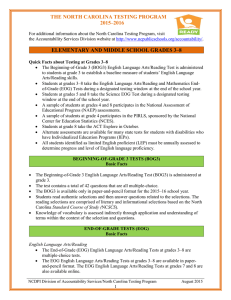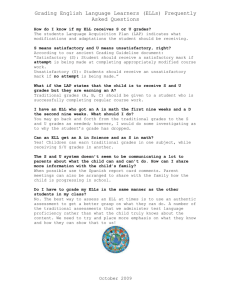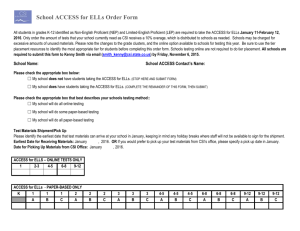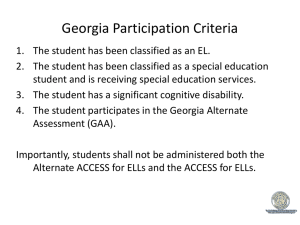2015-2016 Testing Program
advertisement
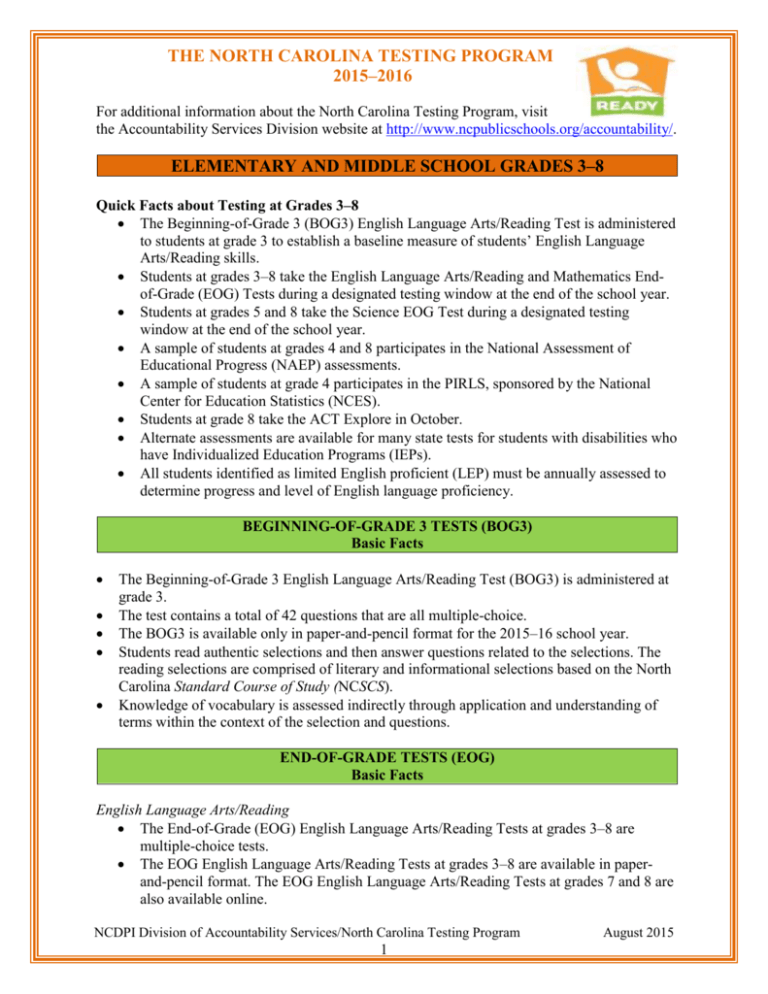
THE NORTH CAROLINA TESTING PROGRAM 2015–2016 For additional information about the North Carolina Testing Program, visit the Accountability Services Division website at http://www.ncpublicschools.org/accountability/. ELEMENTARY AND MIDDLE SCHOOL GRADES 3–8 Quick Facts about Testing at Grades 3–8 The Beginning-of-Grade 3 (BOG3) English Language Arts/Reading Test is administered to students at grade 3 to establish a baseline measure of students’ English Language Arts/Reading skills. Students at grades 3–8 take the English Language Arts/Reading and Mathematics Endof-Grade (EOG) Tests during a designated testing window at the end of the school year. Students at grades 5 and 8 take the Science EOG Test during a designated testing window at the end of the school year. A sample of students at grades 4 and 8 participates in the National Assessment of Educational Progress (NAEP) assessments. A sample of students at grade 4 participates in the PIRLS, sponsored by the National Center for Education Statistics (NCES). Students at grade 8 take the ACT Explore in October. Alternate assessments are available for many state tests for students with disabilities who have Individualized Education Programs (IEPs). All students identified as limited English proficient (LEP) must be annually assessed to determine progress and level of English language proficiency. BEGINNING-OF-GRADE 3 TESTS (BOG3) Basic Facts The Beginning-of-Grade 3 English Language Arts/Reading Test (BOG3) is administered at grade 3. The test contains a total of 42 questions that are all multiple-choice. The BOG3 is available only in paper-and-pencil format for the 2015–16 school year. Students read authentic selections and then answer questions related to the selections. The reading selections are comprised of literary and informational selections based on the North Carolina Standard Course of Study (NCSCS). Knowledge of vocabulary is assessed indirectly through application and understanding of terms within the context of the selection and questions. END-OF-GRADE TESTS (EOG) Basic Facts English Language Arts/Reading The End-of-Grade (EOG) English Language Arts/Reading Tests at grades 3–8 are multiple-choice tests. The EOG English Language Arts/Reading Tests at grades 3–8 are available in paperand-pencil format. The EOG English Language Arts/Reading Tests at grades 7 and 8 are also available online. NCDPI Division of Accountability Services/North Carolina Testing Program 1 August 2015 The tests are aligned to the NCSCS for English Language Arts/Reading. Students read authentic selections and then answer questions related to the selections, which are comprised of literary and informational selections aligned to the NCSCS. Knowledge of vocabulary is assessed indirectly through application and understanding of terms within the context of the selections and questions. Mathematics The EOG Mathematics Tests at grades 3 and 4 are multiple-choice tests. The EOG Mathematics Tests at grades 5–8 are multiple-choice and gridded-response tests. The EOG Mathematics Tests at grades 3–8 are available in paper-and-pencil format. The EOG Mathematics Tests at grades 7 and 8 are also available online. All EOG mathematics tests are aligned to the NCSCS for mathematics. For grades 3–8, the mathematics tests consist of two parts: calculator inactive and calculator active. Students are allowed to use calculators during the calculator active part of the test; students are not allowed to use calculators during the calculator inactive part of the test. Science The EOG Science Tests at grades 5 and 8 are aligned to the Essential Standards for Science. Local Educational Agencies (LEAs)/charter schools have the option of administering the grade 5 EOG Science Test in the online or paper-and-pencil format; however, online testing is strongly encouraged. The grade 8 EOG Science Test is required to be administered online. The online EOG science test questions are multiple-choice and technology-enhanced questions. The paper-and-pencil EOG science tests are strictly multiple-choice. ACT Aspire Basic Facts ACT Aspireis a curriculum-based educational and career planning program for eighth graders that measures achievement in English, math, reading, and science. ACT Aspire includes four multiple-choice tests: o The English test measures understanding of standard written English—punctuation, grammar and usage, and sentence structure—and understanding of the use of strategy, organization, and style in writing. o The math test measures mathematical reasoning. Questions on the test cover four areas—knowledge and skills, direct application, understanding concepts, and integrating understanding of concepts—in prealgebra, elementary algebra, geometry, and statistics and probability. o The reading test measures the student’s ability to understand written material from different school subjects. The skills measured include referring to details in the passage, drawing conclusions, and making comparisons and generalizations. o The science test measures scientific reasoning skills and the student’s ability to understand scientific information and draw conclusions from it. Six sets of scientific information are presented in one of three formats: data representation (graphs, tables, and other forms), research summaries (descriptions of several related NCDPI Division of Accountability Services/North Carolina Testing Program 2 August 2015 experiments), or conflicting viewpoints (two or more hypotheses that are inconsistent with one another). o The ACT Explore also includes a career-exploration component. NATIONAL ASSESSMENT OF EDUCATIONAL PROGRESS (NAEP) (Noble and Trask only) Basic Facts North Carolina has participated in the National Assessment of Educational Progress (NAEP), also known as the Nation’s Report Card, for more than two decades. NAEP is the only nationally representative and continuing assessment of what America’s students know and can do in various subject areas. Selected fourth- and eighth-grade students participate in NAEP. State-level results are reported for grades 4 and 8 in mathematics, reading, science, and writing. This allows comparisons among states and the nation. Selected students at ages 9 and 13 participate in NAEP Long-Term Trend (LLT) assessments. LLT assessments are administered every four years in mathematics and reading. Results are only reported at the national level. Measuring trends of student achievement or change over time requires the precise replication of past procedures. Therefore, the LLT instrument does not evolve based on changes in curricula or educational practices, unlike main NAEP. NAEP has special studies and assessments that are established by the National Assessment Governing Board. For additional information and access to NAEP related resources, visit http://www.ncpublicschools.org/accountability/policies/naep/naep. PROGRESS IN INTERNATIONAL READING LITERACY STUDY (PIRLS) (Ogden only) Basic Facts PIRLS is an international comparative study of the reading literacy of young students in over 53 education systems around the world. Since 2001, PIRLS has focused on the achievement and reading experiences of children in grade 4. Randomly selected fourth-grade students participate in PIRLS. PIRLS provides valuable benchmark information on how United States (U.S.) students compare to students around the world, allows educators and policy makers to examine other education systems for practices that could have application in the U.S., and contributes to ongoing discussions of ways to improve the quality of education for all students. PIRLS is sponsored by the National Center for Education Statistics (NCES), part of the U.S. Department of Education. STATE-IDENTIFIED LANGUAGE PROFICIENCY TESTING Basic Facts North Carolina State Board of Education policy GCS-K-000 (16 NCAC 6D .0106) states that “a home language survey shall be administered to every student at the time of enrollment and maintained in the student’s permanent record.” Language-minority students are identified through a home-language survey (HLS) process. Eligibility for being assessed on the WIDA ACCESS Placement Test (W-APTTM) is based on results of the HLS process. NCDPI Division of Accountability Services/North Carolina Testing Program 3 August 2015 The W-APT is administered to all eligible, initially enrolled, language-minority students (in kindergarten through grade twelve) within thirty (30) calendar days after the beginning of the school year or within fourteen (14) calendar days of enrollment if the student is enrolled after the beginning of the school year. The W-APT is a screener that determines if the student is identified as limited English proficient (LEP). If the student is identified as LEP, the W-APT provides guidance concerning which tier (level) of the English language proficiency test should be administered to the student. The score on the W-APT also determines eligibility for state LEP testing accommodations. The HLS process and the identification and subsequent placement of LEP students in English as a Second Language (ESL) services are guided at the state level by the NCDPI Curriculum and Instruction Division. The annual English language proficiency test, Assessing Comprehension and Communication in English State-to-State for English Language Learners (ACCESS for ELLs® 2.0), is designed to satisfy federal requirements for Title III. The Alternate ACCESS for ELLs® is an assessment of English language proficiency (ELP) for students in grades 1–12 who are identified as language minority students and have significant cognitive disabilities that prevent their meaningful participation in the ACCESS for ELLs 2.0 assessment. The W-APT, the ACCESS for ELLs 2.0, and the Alternate ACCESS for ELLs consist of four subtests that assess the student’s English speaking, listening, reading, and writing skills. All students identified as LEP must be administered the ACCESS for ELLs 2.0 or its alternate assessment during the annual testing window. The ACCESS for ELLs 2.0 is required to be administered online. The results from the annual administration of the ACCESS for ELLs 2.0 are used to measure progress and proficiency of LEP students in the English language. HIGH SCHOOL GRADES 9–12 Quick Facts about Testing at Grades 9–12 Students enrolled for credit in courses where end-of-course (EOC) tests are required must take the appropriate EOC Test. Students at grade 10 take the ACT Plan in October. Students at grade 11 take The ACT in March. Students at grade 12, who are identified as Career and Technical Education (CTE) concentrators, are required to take the ACT WorkKeys assessments. All students identified as LEP must be annually assessed to determine progress and level of English language proficiency. A sample of students at grade 12 participates in the NAEP. A sample of selected 15 year-old students participate in PISA. END-OF-COURSE TESTS (EOC) Basic Facts For 2015–16, the end-of-course (EOC) tests are available for the following subjects: Biology, English II, and Math I. The EOC tests are aligned to the North Carolina Standard Course of Study (NCSCS) for English Language Arts/Reading and Mathematics and the North Carolina Essential Standards for Science. NCDPI Division of Accountability Services/North Carolina Testing Program 4 August 2015 LEAs/charter schools have the option of administering the Biology and Math I EOC tests in either the online or paper-and-pencil format; however, online testing is strongly encouraged. The EOC English II test is required to be administered online. The online EOC English II questions are multiple-choice, technology-enhanced, and constructed-response. The online and paper-and-pencil EOC Math I test questions are multiple-choice and gridded-response. The test consists of two parts: calculator inactive and calculator active. Students may use a calculator only for the calculator active part of the test. The online EOC Biology test questions are multiple-choice and technology-enhanced; the paper-and-pencil test questions are all multiple-choice questions. Per State Board of Education policy GCS-C-003, schools are to use results from all EOC tests as at least 20 percent of the student’s final grade for each respective course. ACT PLAN® Basic Facts ACT Plan is a curriculum-based educational and career planning program for tenth graders. ACT Plan includes four multiple-choice tests: English, math, reading, and science. o The ACT Plan English test measures the student’s understanding of standard written English—punctuation, grammar and usage, and sentence structure—and the use of strategy, organization, and style in writing. o The ACT Plan mathematics test measures mathematical reasoning. The skills tested are those students learn in first- and second-year high school courses (prealgebra, first-year algebra, and plane geometry). o The ACT Plan reading test measures reading comprehension by focusing on skills such as referring to details in a passage, drawing conclusions, and making comparisons and generalizations. o The ACT Plan science test measures scientific reasoning skills based on material that is typically taught in first- and second-year high school general science courses. The material includes topics in biology, chemistry, physics, geology, astronomy, and meteorology. o The ACT Plan also includes a career-exploration component. THE ACT® Basic Facts The ACT is a curriculum- and standards-based assessment that evaluates eleventh graders’ general learning outcomes in English, mathematics, reading, science, and writing. The ACT is used as a college admissions and placement test and is accepted by all four-year colleges and universities in the United States. The English, mathematics, reading, and science tests are multiple-choice tests. The ACT writing test complements the English Test. The combined information from both tests tells postsecondary institutions about students' understanding of the conventions of standard written English and their ability to produce a direct sample of writing. The ACT also includes a career-exploration component. NCDPI Division of Accountability Services/North Carolina Testing Program 5 August 2015 ACT WORKKEYS® Basic Facts Students who are identified as Career and Technical Education (CTE) concentrators, are required to complete the WorkKeys assessments. The three ACT WorkKeys assessments, which are the basis of the National Career Readiness Certificate program, include Applied Mathematics, Locating Information, and Reading for Information. The Applied Mathematics test measures the skills individuals use when they apply mathematical reasoning, critical thinking, and problem-solving techniques to work-related problems. The test questions require the examinee to set up and solve the types of problems and do the types of calculations that occur in the workplace. The test is designed to be taken with a calculator. The Locating Information test measures the skills individuals use when they work with workplace graphics. Examinees are asked to find information in a graphic or to insert information into a graphic. They also must compare, summarize, and analyze information found in related graphics. The Reading for Information test measures the skills individuals use when they read and use written text in order to do a job. The written texts include memos, letters, directions, signs, notices, bulletins, policies, and regulations. Students who achieve qualifying scores on the Applied Mathematics, Reading for Information, and Locating Information assessments can earn a North Carolina Career Readiness Certificate. The certificates provide employers with proof that students have the skills needed to do the jobs available. PROGRAM FOR INTERNATIONAL STUDENT ASSESSMENT (PISA) (Laney only) Basic Facts PISA, first conducted in 2000, is an international assessment that measures reading, mathematics, science, financial literacy, and problem-solving skills every three years in over 70 countries. Randomly selected 15 year-old students participate in PISA. PISA provides educational policymakers with valuable information about the academic skills students have acquired as they near the end of their high school careers. PISA is sponsored by the National Center for Education Statistics (NCES), part of the U.S. Department of Education. STATE-IDENTIFIED LANGUAGE PROFICIENCY TESTING Basic Facts North Carolina State Board of Education policy GCS-K-000 (16 NCAC 6D .0106) states that “a home language survey shall be administered to every student at the time of enrollment and maintained in the student’s permanent record.” Language-minority students are identified through a home-language survey (HLS) process. Eligibility for being assessed on the WIDA ACCESS Placement Test (W-APTTM) is based on results of the HLS process. The W-APT is administered to all eligible, initially enrolled language-minority students (in kindergarten through grade twelve) within thirty (30) calendar days after the beginning of NCDPI Division of Accountability Services/North Carolina Testing Program 6 August 2015 the school year or within fourteen (14) calendar days of enrollment if the student is enrolled after the beginning of the school year. The W-APT is a screener that determines if the student is identified as limited English proficient (LEP). If the student is identified as LEP, the W-APT provides guidance concerning which tier (level) of the English language proficiency test should be administered to the student. The score on the W-APT also determines eligibility for state LEP testing accommodations. The HLS process and the identification and subsequent placement of LEP students in English as a Second Language (ESL) services are guided at the state level by the NCDPI Curriculum and Instruction Division. The annual English language proficiency test, Assessing Comprehension and Communication in English State-to-State for English Language Learners (ACCESS for ELLs® 2.0), is designed to satisfy federal requirements for Title III. The Alternate ACCESS for ELLs® is an assessment of English language proficiency (ELP) for students in grades 1–12 who are identified as language-minority students and have significant cognitive disabilities that prevent their meaningful participation in the ACCESS for ELLs 2.0 assessment. The W-APT, the ACCESS for ELLs 2.0, and the Alternate ACCESS for ELLs consist of four subtests that assess the student’s English speaking, listening, reading, and writing skills. All students identified as LEP must be administered the ACCESS for ELLs 2.0 or its alternate assessment during the annual testing window. The ACCESS for ELLs 2.0 is required to be administered online. The results from the annual administration of the ACCESS for ELLs 2.0 are used to measure progress and proficiency of LEP students in the English language. ALTERNATE ASSESSMENTS Quick Facts about Alternate Assessments The alternate assessments were designed to ensure access to the statewide testing program for students with disabilities who cannot participate in the general assessments. The available alternate assessments are the NCEXTEND1, the College and Career Readiness Alternate Assessment at Grade 10, the College and Career Readiness Alternate Assessment at Grade 11, and the Alternate ACCESS for ELLs. NCEXTEND1 Basic Facts The NCEXTEND1 is designed for students with significant cognitive disabilities. The assessment process requires students to complete performance-based, multiple-choice items. Assessment items align with the North Carolina Extended Content Standards for English language arts/reading, mathematics, and science. The NCEXTEND1 measures student performance in the following subject areas: o English language arts/reading at grades 3–8, 10, and 11; o Mathematics at grades 3–8, 10, and 11; and o Science at grades 5, 8, 10, and 11. The NCEXTEND1 is designed for students with disabilities who o have a current Individualized Education Program (IEP); o are enrolled in grades 3–8, 10, or 11 according to PowerSchool; NCDPI Division of Accountability Services/North Carolina Testing Program 7 August 2015 o are instructed in the North Carolina Extended Content Standards in all assessed content areas; and o have a significant cognitive disability (i.e., exhibit severe and pervasive delays in all areas of conceptual, linguistic, and academic development and also in adaptive behavior areas, such as communication, daily living skills, and self-care). The vast majority of students with disabilities do not have a significant cognitive disability. The NCEXTEND1 is not appropriate for students who o are being instructed in any or all of the general grade-level content standards of the North Carolina Standard Course of Study or the Essential Standards; o demonstrate delays only in academic achievement; o demonstrate delays owing primarily to behavioral issues; o demonstrate delays only in selected areas of academic achievement; or o if in high school, are pursuing a North Carolina high school diploma (including students enrolled in the Occupational Course of Study). The NCEXTEND1 Alternate Assessment is designed for students who have a severe intellectual disability; it is NOT designed for students who have a specific learning disability. The NCEXTEND1 Alternate Assessments at grades 3‒8, 10, and 11 are administered during designated testing windows. COLLEGE AND CAREER READINESS ALTERNATE ASSESSMENT GRADE 10 Basic Facts The College and Career Readiness Alternate Assessment at Grade 10 (CCRAA 10) is an alternate assessment for eligible students with disabilities who have Individualized Education Programs (IEPs). The CCRAA 10 is designed as an alternate assessment for participation in the ACT Plan. The CCRAA 10 is appropriate for students enrolled in tenth-grade who o exhibit severe and pervasive delays in all areas of conceptual, linguistic, and academic development and in adaptive behaviors, including communication, daily living skills, and self-care; o are following a course of study that, upon completing high school, may not lead to admission into a college-level course of study resulting in a college degree (i.e., the Occupational Course of Study); o ARE NOT receiving instruction in the North Carolina Extended Content Standards, and o have a written parental request for an alternate assessment. The CCRAA 10 contains multiple-choice questions. The administration of the CCRAA 10 occurs simultaneously with the ACT Plan administration during the month of October. COLLEGE AND CAREER READINESS ALTERNATE ASSESSMENT GRADE 11 Basic Facts The College and Career Readiness Alternate Assessment at Grade 11 (CCRAA 11) is an alternate assessment for eligible students with disabilities who have IEPs. The CCRAA 11 is designed as an alternate assessment for participation in The ACT. The CCRAA 11 is appropriate for students enrolled in eleventh-grade who NCDPI Division of Accountability Services/North Carolina Testing Program 8 August 2015 o exhibit severe and pervasive delays in all areas of conceptual, linguistic, and academic development and in adaptive behaviors, including communication, daily living skills, and self-care; o are following a course of study that, upon completing high school, may not lead to admission into a college-level course of study resulting in a college degree (i.e., the Occupational Course of Study); o ARE NOT receiving instruction in the North Carolina Extended Content Standards (Note: Students receiving instruction in the North Carolina Extended Content Standards may be eligible for the NCEXTEND1 Alternate Assessment at Grade 11); and o have a written parental request for an alternate assessment. The CCRAA 11 contains multiple-choice questions and one constructed-response item. The CCRAA 11 is administered during The ACT accommodations testing window in March. ALTERNATE ACCESS FOR ELLs Basic Facts The Alternate ACCESS for ELLs is an assessment of English language proficiency for students in grades 1–12 who are classified as English language learners (ELLs) and have significant cognitive disabilities that prevent their meaningful participation in the ACCESS for ELLs® 2.0 assessment. The Alternate ACCESS for ELLs has four assessment domains: Listening, Reading, Writing, and Speaking. The Listening and Reading sections consist of multiple-choice questions. The Writing and Speaking sections prompt the students for a constructed response. All sections are adaptive, meaning that the test items are presented until the student reaches his/her performance “ceiling.” Other unique features of the test include simplified language, repetition of questions, increased graphic support, larger testing materials, and graphics. NCDPI Division of Accountability Services/North Carolina Testing Program 9 August 2015


